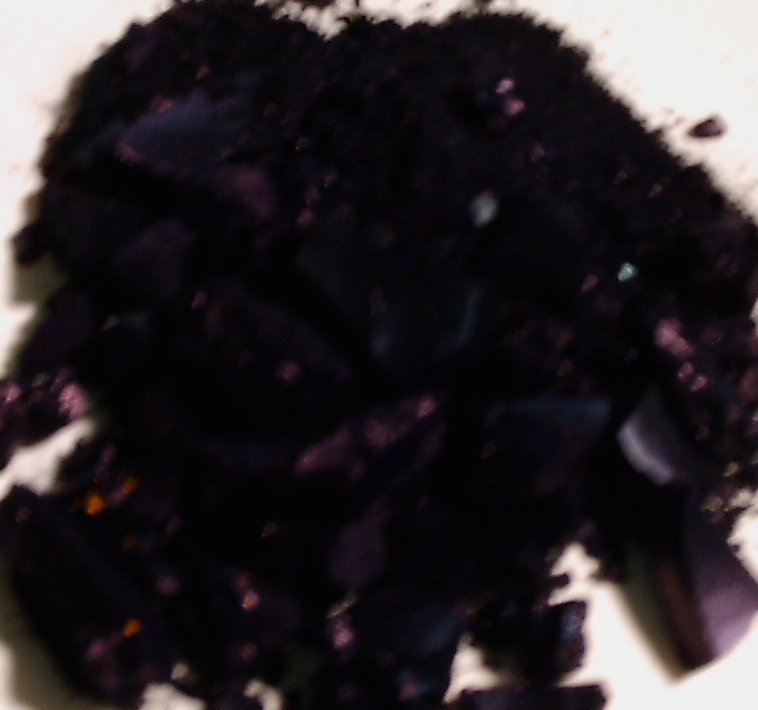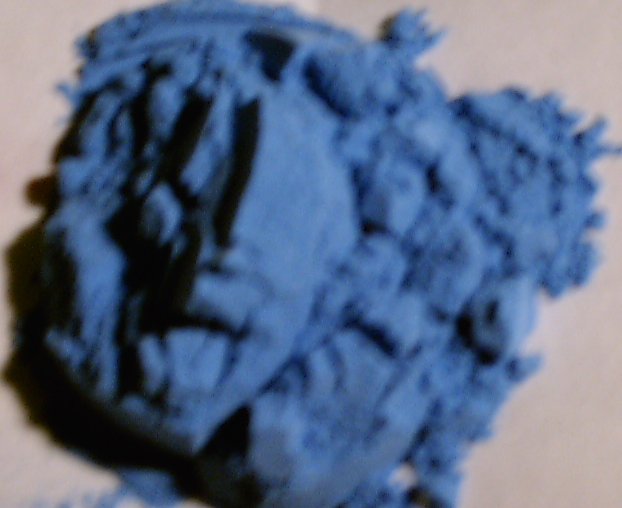Blue
On this page is information about blue colours. These are:
- Ultramarine (Synthetic Lazurite)
- Smalt / Royal Blue
- Chessylite / Azurite
- Cobalt Blue
- Cerulean Blue
- Prussian Blue
- Indigo
- Egyptian Blue
- Lazurite
- Posnjakite
- Phthalocyanine
Ultramarine (Synthetic Lazurite)

Use - Paint pigment, plastics pigment
Formula - Na8-x[AlSiO4]6[S3, S2]2-2x
Chemical Name - Synthetic Lazurite
Structure - Cubic
Synthesis - Kaolin, silica, sodium sulfte, sodium carbonate, sulfur and charcoal are heated in a furnace. The mixture is cooled and controlled oxidation performed before being cooled to room temperature, powdered and then dried.
Interesting Facts - Ultramarine blue has been used in washing powders, and is a safe blue compound. Blue plastic bottles are coloured with ultramarine pigment.
Smalt / Royal Blue
Use - Colouring glass and as a paint pigment
Formula - Co2SiO4
Chemical Name - Cobalt(II) silicate
Structure - Cubic
Synthesis - Silica, potash, cobalt oxide and alumina are heated to a moderate temperate. The mixture is cooled and ground into a fine powder.
Interesting Facts - n/a
Chessylite / Azurite

Use - Paint pigment
Formula - 2CuCO3 • Ca(OH)2
Chemical Name - Copper(II) carbonate - copper(II)hydroxide
Structure - Monoclinic
Synthesis - Naturally occuring mineral
Interesting Facts - n/a
Cobalt Blue

Use - Paint pigment
Formula - CoO • Al2O3
Chemical Name - Cobalt(II) oxide - aluminium oxide
Structure - Cubic
Synthesis - Heat a mixture of cobalt oxide and aluminium chloride.
Interesting Facts - n/a
Cerulean Blue
Use - Paint pigment
Formula - CoO • nSnO2
Chemical Name - Cobalt(II) stannate
Structure - n/a
Synthesis - Tin oxide is added to an aqueous solution of cobalt nitrate and heated. Alternatively mix a solution of postassium stannate and cobalt chlordie, then wash and heat the precipitate.
Interesting Facts - n/a
Prussian Blue

Use - Paint pigment
Formula - Fe4[Fe(CN)6]3
Chemical Name - Iron(III) hexacyanoferrate
Structure - Cubic
Synthesis - Mix postassium cyanoferrate and iron chloride solutions. Dry and grind the resultant precipitate.
Interesting Facts - Discovered in 1710 by a colour maker in Berlin called Diesbach.
Indigo

Use - Paint pigment or dye for clothes
Formula - C16H10N2O2
Chemical Name - 2,2-biindolingliden-3,3-dione
Structure - n/a
Synthesis - Soak, ferment,dry and then grind the indigofera tirctoria shrub.
Interesting Facts - In 1890 £4 000 000 worth of the indgofera tirctoria plant was imported from india.
Indigo was also used to dye the bandages used to mummify the dead in ancient Egypt. It was also used 2700 years ago by the Babylonians in Mesopotamia.
Egyptian Blue

Use - Paint pigment
Formula - CaCuSi4O10
Chemical Name - Calcium copper(II) silicate
Structure - Tetragonal
Synthesis - Heat a mixture of 4 parts silicon dioxide to one part calcium oxide and one part copper oxide to 900°C using a borax flux. Then maintain the mixture at 800°C for at least 10 hours.
Interesting Facts - Was originally made by the ancient Egyptians.
Lazurite

Use - Paint pigment
Formula - Na8-x[AlSiO4]6[S3, S2]2-2x
Chemical name - Lazurite
Structure - Cubic
Synthesis - From the mineral Lazurite
Interesting Facts - The best Lazurite is mined in Afghanistan. Lazurite was first used in around 600AD. The cost was so expensive that only very important paintings were created using Lazurite.
Poznjakite
Use - Paint pigment
Formula - CuSO4 • 3Ca(OH)2 • H2O
Chemical Name - Basic copper(II) sulfate
Structure - Monoclinic
Synthesis - From mineral deposits.
Interesting Facts - n/a
Phthalocyanine
Use - Solvent dye
Formula - [C32H16N8]2-
Chemical Name - Tetrabenzoporphyracin
Structure - Complex conjugated structure
Synthesis - n/a
Interesting Facts - Used to produce the coloures direct blue 86, 199, 38 and 48. Also used to produce phthalocyanine blue and green.






